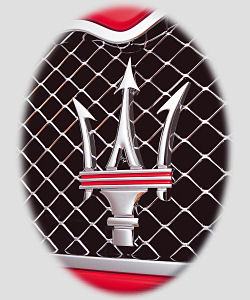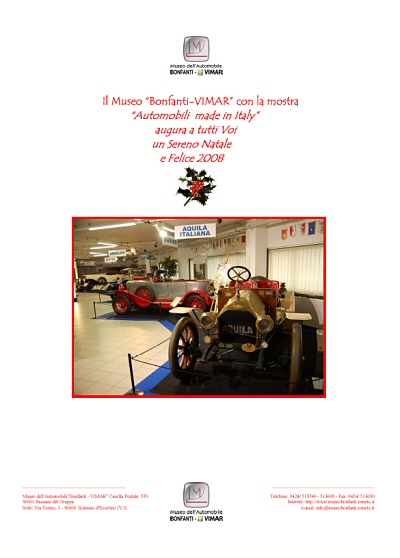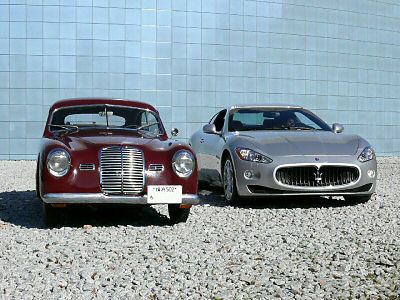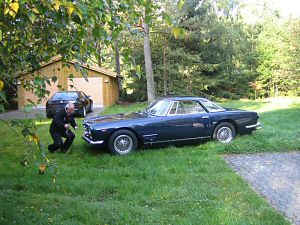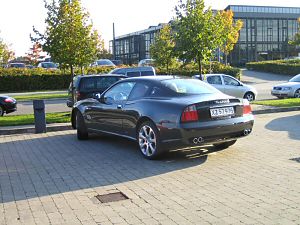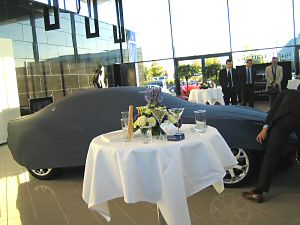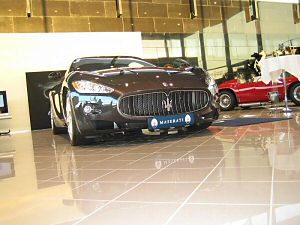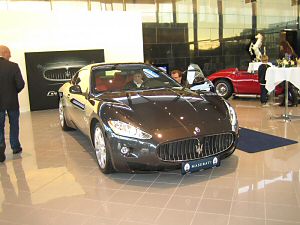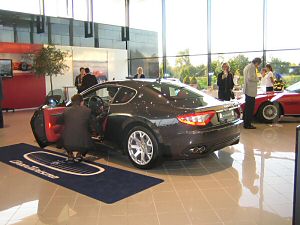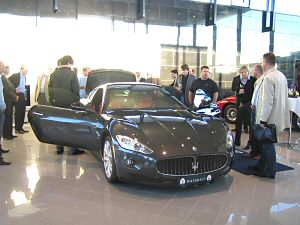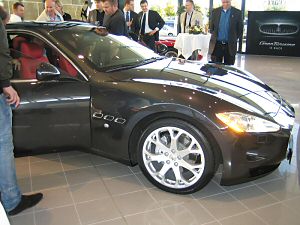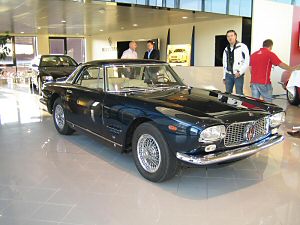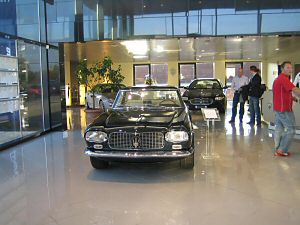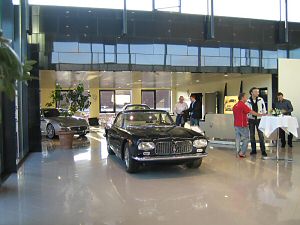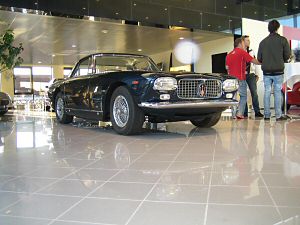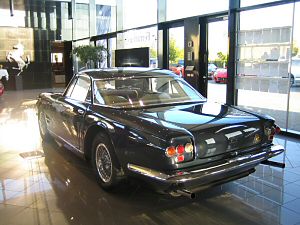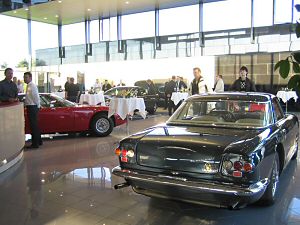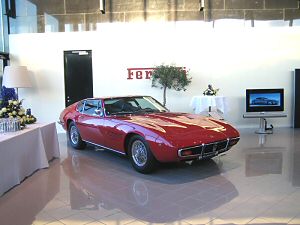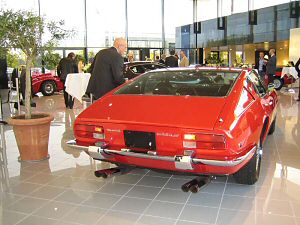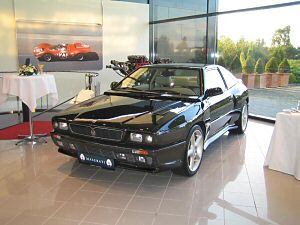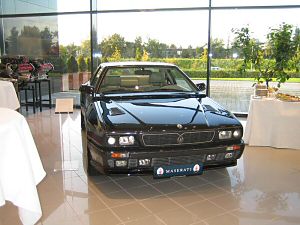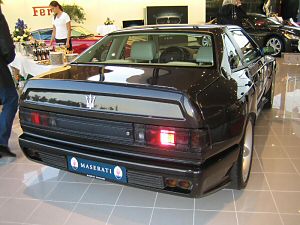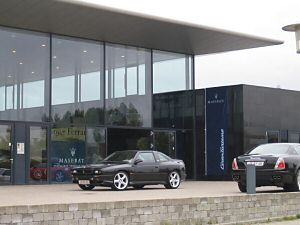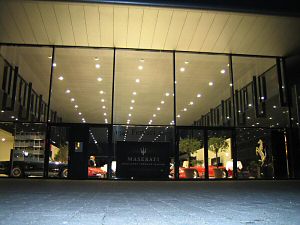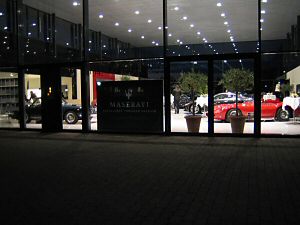| |
| |
 |
| |
| |
|
From Bonhams at Gstaad |
| |
| |
On the 19th December 2007 at Gstaad, Bonhams will be holding a sale entitled "Ferrari et les Prestigieuses Italiennes" & Related Automobia.
The sale contains one rare Maserati race car, four interesting classic Maserati road cars, and several highly collectable items of Maserati books and memorabilia.
The full catalogue listings can be found at www.bonhams.com |
|
|
The Maserati Race Car |
|
|
Lot No: 232
The ex-Count ‘Johnny’ Lurani, Italian Championship-winning 1937 Maserati 4CM Monoposto
Chassis no. 1128
Engine no. 1128
Estimate: CHF860,000 - 960,000
NOT SOLD. |
 |
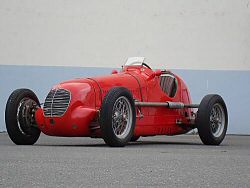
A 1937 Maserati 4CM Monoposto |
|
Of the six surviving Maserati brothers, all except Mario would go on to become motor engineers; and even Mario had a role to play in the marque’s foundation, designing its famous Trident badge, which is said to have been inspired by the statue of Neptune in Bologna, where the factory was situated at Pontevecchio. Società Anonima Officine Maserati was set up in December 1914 by Alfieri Maserati, specialising in the tuning and repair of Isotta-Fraschini motor cars. After the end of The Great War, Alfieri and his brother Ettore were recruited to manage Diatto’s racing programme, and when that company withdrew from active competition the pair, together with Ernesto Maserati, set up on their own.
The Maseratis were racing specialists – the first Maserati road car would not appear for several years – and their first product was a 1.5-litre supercharged straight eight intended for the formula that commenced in 1926. It would turn out to be an auspicious debut, for the new Tipo 26, crewed by Alfieri Maserati and mechanic Guerino Bertocchi, won its class in that year’s Targa Florio. As a low volume producer whose products were aimed at wealthy enthusiasts, Maserati was relatively unaffected by the Depression and production increased steadily if unspectacularly; of the ten Tipo 26s built up to 1928, four were used by the works and six sold to privateers.
The Formule Libre years of the early Thirties would see Maserati achieve its first Grand Prix victory, when Baconin Borzacchini won the Tripoli GP in 1930 at the wheels of the V16-engined ‘V4’, but within a few years the Bologna firm would find itself relegated from racing’s front rank by the might of the state-backed Mercedes-Benz and Auto Union teams. Maserati responded by concentrating its efforts on the voiturette class, which was not contested by the German manufacturers, enjoying considerable success in that category. First introduced in 1931, the 1,100cc Tipo 4CM was Maserati’s first racing voiturette. Built alongside the 4CS two-seater sports-racer, the 4CM monoposto was powered by a 1,088cc twin-overhead-camshaft supercharged ‘four’ that produced 125bhp at 6,600rpm, an output sufficient to propel these compact little cars to a top speed of 130mph.
Delivered new in 1937 to Count Giovanni Lurani Cernuschi, better known in motor racing circles as ‘Johnny’ Lurani, one of the founder members of Scuderia Ambrosiana together with Luigi Villoresi and Franco Cortese, chassis number ‘1128’ is one of the very last Tipo 4CMs made. Manufactured in February 24th 1937 and supplied in 1,100cc specification, ‘1128’ came with a spare cylinder block, pistons, connecting rods and supercharger enabling it to be converted to 1,500cc when required. Lurani was very successful with this car throughout the 1937 and 1938 seasons, winning the 1,100cc category at Turin, Milan, Genoa, Naples and Palermo, and taking the Italian National Championship. (A full list of this car’s race results can be found in the Adolfo Orsi archive).
‘1128’ was one of four Maseratis taken to South Africa in the winter of 1937/38 by Scuderia Ambrosiana. At Cape Town, the last stop on the itinerary, Lurani shared the 4CM with Villoresi, who took over the drive when in 6th place and had worked the unfancied 1½-litre car up to a fighting 3rd place at the finish. On its return the 4CM was rebuilt in Italy in preparation for the forthcoming season. Lurani ran the car in 1,500cc form at the Tripoli Grand Prix, where he set fastest lap and finished third, and in the Targa Florio where he retired, before converting it back to 1,100cc, for handicap reasons, for the London Grand Prix in June. Held at the Crystal Palace circuit, this event would prove to be a fateful one for the Count, who overturned his 4CM in practice, breaking a hip. The car was only superficially damaged but Lurani’s injury was severe enough to end his monoposto racing career. ‘I acted as a cushion for the car when it landed,’ he was quoted as saying. With his single-seater career now over, Lurani advertised the 4CM in The Motor with an asking price of £795. The car was advertised as in 1,500cc form, with spares to convert the engine to 1,100cc, and guaranteed to exceed 140mph.
While Lurani was convalescing, the car was repaired and raced by W G ‘Bill’ Everitt and Achile Varzi before being sold via BRDC secretary, Desmond Scannell to ex-racing motorcyclist and Isle of Man TT winner, C J P ‘Charlie’ Dodson. Dodson raced the car at the 1939 British Empire Trophy race at Donington Park and once more that same year at the Nuffield Trophy race, running with the leaders on both occasions only to retire.
The car was not seen again until after the war, when it was spotted by Lurani at the Montlhéry autodrome near Paris in 1948, now painted blue and raced by a French driver. In the early 1960s the car resurfaced once more in Marseilles. Lurani decided not to buy it and the battle-scarred but still complete 4CM was purchased by Swiss enthusiast Hermann Richenberger in February 1964. Richenberger consulted the Maserati archive, obtaining a copy of the original sales invoice to Lurani, which the car retains today. With professional assistance Mr Richenberger embarked on a painstaking and meticulous restoration to return the car to its former glory, retaining a maximum of original parts.
At the completion of this 1,600-hour restoration the Maserati was exhibited on August 31st 1968 at the Expo de la Côte at Rolle on Lake Geneva and pictured in the Swiss Automobile Revue of September 19th that same year together with around 50 other collector’s cars from the area. The car was subsequently drained of all fluids and spent the next 38 years hanging on its owner’s wall like a great artist’s masterpiece - which is, of course, what it is - before being sold to the current owner at the Le Mans Classic auction in July 2006.
After such a lengthy period in quiet retirement, ‘1128’ will almost certainly require a certain amount of re-commissioning before resuming its career on the racetrack, if that is what its fortunate new owner so chooses. Eligible for a wide variety of the most prestigious motor sporting events like the Grand Prix de Monaco Classic, this wonderful car represents a rare opportunity to acquire an historic Maserati monoposto with in-period Grand Prix history, driven by some of the greatest drivers of its era. |
|
|
The Classic Maserati Road Cars |
|
|
Lot No: 206
27,000 kilometres from new, one of only 123 built
1969 Maserati Mistral 3.7-Litre Spyder
Coachwork by Carrozzeria Frua
Chassis no. AM109S1 731
Engine no. AM109S 731
Estimate: CHF200,000 - 250,000
SOLD FOR CHF 304,572 including buyer's premium. |
 |
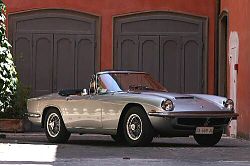
A Maserati Mistral Spyder |
|
'We do not suppose there are many cars whose names conjure up an aura of exotic glamour to the same extent as that of Maserati. Even now, many years after the company has withdrawn from any form of competition, past glories linger on.’ - Sporting Motorist.
Maserati’s survival strategy for the 1960s centred on establishing the company - which hitherto had mainly concentrated on its Grand Prix and sports car racing activities - as a producer of road cars. The Modena marque’s new era began in 1957 with the launch at the Geneva Salon of the Touring-bodied 3500GT. A luxury 2+2, the 3500GT drew on Maserati’s competition experience, employing a tubular chassis frame and an engine derived from the 350S sportscar unit of 1956. Suspension was independent at the front by wishbones and coil springs, while at the back there was a conventional live axle/semi-elliptic arrangement. Power output of the gorgeous twin-cam six was around 220bhp initially, later examples producing 235bhp.
Last of these classic six-cylinder Maseratis, the Pietro Frua-styled Mistral commenced production in 1963. The 3.7-litre version of the Bolognese manufacturer’s long-stroke engine was fitted to most cars, other options being the 3.5-litre or, from 1966, the 4.0-litre unit. A handsome two-seater on a shortened, square-tube chassis, the Mistral was built in coupé and spyder versions, the former’s opening rear window hatch making it an unusually practical car. A five-speed gearbox, disc brakes and fuel injection were standard equipment; automatic transmission, air conditioning and a limited-slip differential the options. Production ceased in 1970, by which time a total of 827 coupés and 123 spyders had been built.
We are advised that this 3.7-litre Mistral Spyder was delivered new in Italy on the 12th February 1969 and first owned by one Hami Hamouda. By 1978 the car was in the ownership of Mr Farag Owad Bessituni and, reputedly, was later sold to the King of Morocco. The car, which has appeared on the front cover of Ruoteclassiche magazine (July 2004 issue), is offered for sale following the recent death of its owner, whose name appears in the accompanying Automotoclub Storico Italiano registration papers issued in September 1997. Finished in silver with black leather interior, the car is presented in superb condition and represents a rare opportunity to acquire a fine example of one of Maserati’s most stylish soft-tops. |
|
|
|
Lot No: 213
1971 Maserati Ghibli SS Coupé
Coachwork by Carrozzeria Ghia
Chassis No. AM115/49*1990*
Engine No. 2775
Estimate: CHF120,000 - 140,000
NOT SOLD. |
 |
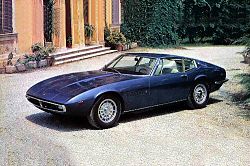
A Maserati Ghibli SS Coupé |
|
A strong contender for the ‘most handsome car of the 1960s’ title, Maserati’s Ghibli debuted in coupé form at the Turin Motor Show in November 1966. Styled at Carrozzeria Ghia by Giorgetto Giugiaro and named after a Sahara Desert wind, the Ghibli rivalled the Ferrari Daytona for straight-line performance - its top speed was close to 170mph (275km/h) - while matching it for price and arguably beating it for looks. More than 4.5m long and 1.8m wide, the Ghibli occupied an inordinate amount of space for a mere two-seater, but perhaps the most startling aspect of its appearance was the height, or rather the lack of it. Dry-sump lubrication enabled the engine to be mounted deep in the chassis, permitting a low bonnet line, while limited suspension travel ensured that the tyres did not foul the wheel arches. The roofline fell away from the top of the steeply raked windscreen to the chopped-off tail, Giugario thus achieving a cabin lower than that of almost all the Ghibli’s contemporaries, albeit one which left no room for rear passengers.
Like the contemporary Mexico 2+2, the Ghibli used a shortened version of the Quattroporte saloon’s tubular steel chassis in its live rear axle form. Perhaps surprisingly, the Ghibli set-up used leaf springs and a single locating arm in preference to the more complex suspension arrangements favoured by its rivals. The power unit was Maserati’s venerable, four-cam, 90-degree V8, an engine derived from that of the 450S sports racer and first seen in road-going guise in the 5000GT. This was used in 4.7-litre form up to 1970 when it was superseded by the 4.9-litre ‘SS’ version. The SS gained transistorised ignition and new Weber 42DCNF carburettors, showing a small horsepower increase but greater torque; in either case performance was stunning, with 100mph (160km/h) attainable in under 16 seconds and a claimed top speed (for the SS) of 175mph. This neck-snapping acceleration resulted from the V8’s broad power band, which made the Ghibli one of the most flexible and easy-to-drive GTs of its era. Ghibli production ceased in 1973 after approximately 1,149 coupé and 125 spyder models had been built.
Supplied new in February 1971 to a client in the wealthy shipping port of Livorno in Tuscany, Italy, this Ghibli represents the model in its ultimate form, with 4.9-litre ‘SS’ engine and five-speed manual gearbox, and has had only two recorded owners. Finished in its original Blu Pervinca Metalizzato (metallic peacock blue) with cream leather interior, the car has spent all its life in its home country and is presented in very good condition in every respect. It is offered with bills for work carried out by various well known specialists, Italian libretto and valid roadworthiness certificate (last carried out on 26/3/2007). It has air conditioning, period radio and power steering and is fitted with the correct Campagnolo alloy wheels. A complete factory tool roll sits in the boot and the car also has ASI (Italian Historic Car Club) homologation. The odometer shows 38,179km, which is commensurate with the car’s condition.
One of the most stunning Granturismo cars ever made, the Ghibli was a worthy rival for the Ferrari Daytona and represents exceptional value for money today, though values are now rising quickly. Local taxes will be liable if the car remains in Switzerland. |
|
|
|
Lot No: 218
1970 Maserati Ghibli 4.7-Litre Spyder
One of only 125 Ghibli Spyders produced
Coachwork by Carrozzeria Ghia
Chassis no. AM115S 1025
Estimate: CHF310,000 - 350,000
NOT SOLD. |
 |
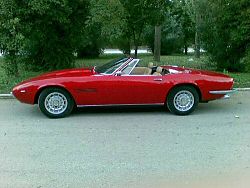
A Maserati Ghibli Spyder |
|
A strong contender for the ‘most handsome car of the 1960s’ title, Maserati’s Ghibli debuted in coupé form at the Turin Motor Show in November 1966. Styled at Carrozzeria Ghia by Giorgetto Giugiaro and named after a Sahara Desert wind, the Ghibli rivalled the Ferrari Daytona for straight-line performance - its top speed was close to 170mph (275km/h) - while beating it for price and, arguably, looks.
More than 4.5m long and 1.8m wide, the Ghibli occupied an inordinate amount of space for a mere two-seater, but perhaps the most startling aspect of its appearance was the height, or rather the lack of it. Dry-sump lubrication enabled the engine to be mounted deep in the chassis, permitting a low bonnet line, while limited suspension travel ensured that the tyres did not foul the wheelarches. The roofline fell away from the top of the steeply raked windscreen to the chopped-off tail, Giugario thus achieving a cabin lower than that of almost all the Ghibli’s contemporaries, albeit one with restricted headroom for rear passengers.
Like the contemporary Mexico 2+2, the Ghibli used a shortened version of the Quattroporte saloon’s tubular steel chassis in its live rear axle form. Perhaps surprisingly, the Ghibli set-up used leaf springs and a single locating arm in preference to the more complex suspension arrangements favoured by its rivals. The power unit was Maserati’s venerable, four-cam, 90-degree V8, an engine derived from that of the 450S sports racer and first seen in road-going guise in the 5000GT. This was used in 4.7-litre form up to 1970 when it was superseded by the 4.9-litre ‘SS’ version in order to meet ever more stringent emission laws. The gain in horsepower was minimal, but in either case performance was stunning, with 100mph (160km/h) attainable in under 16 seconds. Even more sensational was the handsome Ghibli Spyder, launched in 1969 and the direct rival of Ferrari’s Daytona Spyder. Giugiaro’s styling for an open Ghibli was arguably even more successful than the original closed coupé and is rightly regarded as an all-time classic of sports car design. Ghibli production ceased in 1973 after approximately 1,149 coupé and 125 spyder models had been built.
This Ghibli Spyder, chassis number ‘1025’, left the factory in June 1969 and was delivered new in Milan in 1970 to the Società Immobiliare Nuova Esmeralda. Records show that the car was equipped with the five-speed manual gearbox and originally finished in oro metalizzatto (gold metallic) with cream Connolly leather interior. Much of its subsequent history is unknown, but by 1996 ‘1025’ was resident in the USA in the ownership of Mr Oliver Cromwell, of Bronxville, New York. The accompanying file of invoices relating to Mr Cromwell’s period of ownership and dating from 1996 to 2002 – close inspection of which is recommended – reveals a ‘no expense spared’ approach to servicing, maintenance and restoration. Most of these invoices were issued by recognised specialists Vantage Motors Inc, of Stamford, Connecticut for renovation that included overhauling the carburettors and air conditioning system (March 1996 at 54,239 miles); a total engine rebuild (January 1998 at 54,256 miles) and extensive bodywork repairs, bare-metal repaint and a new convertible hood (May-October 2000 at 54,256 miles). The most recent of these invoices (dated 22nd November 2002) is for a full service carried out at 57,258 miles.
In 2004 the car was awarded the ‘Best Maserati’ prize at the prestigious Greenwich Concours d’Elegance before passing into the possession of the current vendor, who returned it to Europe and registered it in Greece in 2006. We are advised that the immediately preceding American owner had covered only 4,800 miles since completing the car’s restoration. Refinished in red while retaining its original cream leather interior, ‘1025’ benefits from new Pirelli tyres and is offered with the aforementioned servicing/restoration history, FIA papers, Greek registration document (GR855) and recent invoices (autumn 2007) relating to the installation of a new fuel pump, brake cable and clutch. A rare and well-restored example of Maserati’s answer to the Ferrari Daytona in its most desirable spyder specification.
|
|
|
|
Lot No: 230
c.1960 Maserati 3500GT Series 1 Coupé
Coachwork by Carrozzeria Touring
Chassis no. AM101.1218
Engine no. AM101.1218
Estimate: CHF80,000 - 100,000
SOLD FOR CHF 103,383 including buyer's premium. |
 |
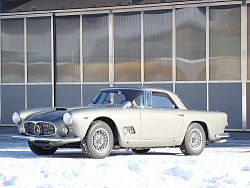
A Maserati 3500GT Series 1 Coupé |
|
Despite numerous racetrack successes that included Juan Manuel Fangio’s fifth World Championship - at the wheel of a 250F - and runner-up spot in the World Sports Car Championship with the fabulous 450S - both in 1957, the marque’s most successful season - Maserati was by that time facing a bleak future. Its parent company’s financial difficulties forced a withdrawal from racing, and Maserati’s survival strategy for the 1960s centred on establishing the company as a producer of road cars.
The Modena marque’s new era began in 1957 with the launch of the Touring-bodied 3500GT, its first road car built in significant numbers. A luxury 2+2, the 3500GT drew heavily on Maserati’s competition experience, employing a tubular chassis frame and an engine derived from the 350S sportscar unit of 1956. Suspension was independent at the front by wishbones and coil springs, while at the back there was a conventional live axle/semi-elliptic arrangement. The 3500GT’s designer was none other than Giulio Alfieri, creator of the immortal Tipo 60/61 ‘Birdcage’ sports-racer and the man responsible for developing the 250F into a World Championship winner.
The twin-overhead-camshaft, six-cylinder engine was a close relative of that used in the 250F and developed around 220bhp initially, later examples producing 235bhp on Lucas mechanical fuel injection. Built initially with drum brakes and four-speed transmission, the 3500GT was progressively updated, gaining five speeds, front disc brakes and, finally, all-disc braking before production ceased in 1964, by which time 2,223 cars had been made.
This Series 1 3500GT has the easier-to-maintain carburettor engine, desirable five-speed manual gearbox, front disc brakes, Borrani wire wheels and electric windows, and is finished in grey with original black leather interior. The car was acquired by the immediately preceding Swiss owner in 1996 and benefits from an engine rebuilt in 1998 by Tralli in Maserati’s hometown of Modena. It was purchased by the current owner at Bonhams’ Les Grandes Marques à Monaco sale on 15th May 2004 (Lot 221) and was found to drive well on a recent test run. A landmark model from the famous Modenese manufacturer, the car is offered with Netherlands registration papers and is tax-paid in Switzerland, having previously been registered there. |
|
|
The Maserati and Maserati Related Memorabilia |
|
|
Lot No: 4
Two Maserati brochures, the first a Bora the other a Merak, in colour, 4to.
Estimate: CHF170 - 270
NOT SOLD. |
 |
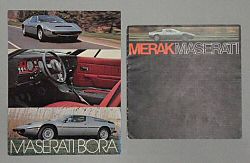
Maserati Bora and Merak brochures |
|
|
|
Lot No: 10
Three items of Maserati Khamsin ephemera, two brochures the other the Khamsin road test by 'Road & Track' magazine, all 4to.
(3)
Estimate: CHF200 - 300
NOT SOLD. |
 |
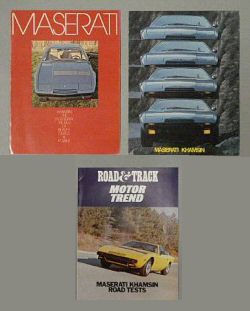
Maserati Khamsin brochures and road test |
|
|
|
Lot No: 16
A pair of lates 1960s Maserati brochures,
the first for the Ghibli the other for the Indy, both fold out types with illustrations.
(2)
Estimate: CHF250 - 350
SOLD FOR CHF260 including buyer's premium. |
 |
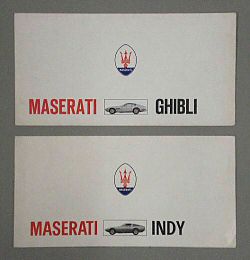
Maserati Ghibli and Indy brochures |
|
|
|
Lot No: 17
A pair of Maserati brochures,
the first for the Mexico the other for the Sebring, both fold out type in soft card, illustrated, 4to.
(2)
Estimate: CHF250 - 350
NOT SOLD. |
 |
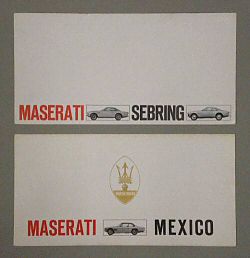
Maserati Sebring and Mexico brochures |
|
|
|
Lot No: 22
A selection of Maserati related literature,
including Denis Jenkinson: Maserati 3011 The Story of a Racing Car; Luigi Orsini Franco Zagari: Maserati Una Storia nella Storia; Richard Crump and Rob de la Riva Box: Maserati Sports Racing and GT cars 1926 - 1975; and others.
(6)
Estimate: CHF290 - 380
SOLD FOR CHF240 including buyer's premium. |
 |
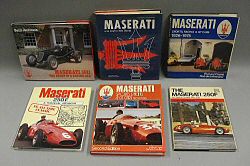
Selection of 6 Maserati books |
|
|
|
Lot No: 32
Joel E Finn: Maserati: The Postwar Sporstracing cars;
together with Joel E Finn: Maserati Birdcage; good condition.
(2)
Estimate: CHF360 - 480
SOLD FOR CHF800 including buyer's premium. |
 |
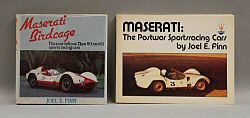
Maserati books by Joel E Finn |
|
|
|
Lot No: 34
Two Maserati Mistral brochures,
both fold out type in soft card, many illustrations both colour and monochrome.
(2)
Estimate: CHF375 - 475
NOT SOLD. |
 |
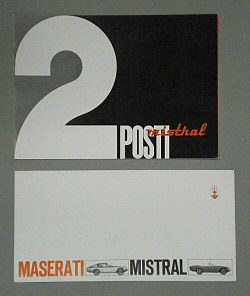
Two Maserati Mistral brochures |
|
|
|
Lot No: 82
Three photographs depicting Maserati cars at the 1957 Sebring 12 hours
Estimate: CHF250 - 350
SOLD FOR CHF100 including buyer's premium. |
 |
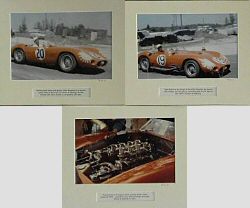
Three Maserati photographs |
|
|
|
Lot No: 119
A Maserati Monoposto car mascot, circa 1930s,
a finely detailed representation of a pre-war Maserati single-seat racing car, chrome plated bronze, mounted on a period chrome plated radiator cap.
Estimate: CHF1,000 - 1,200
SOLD FOR CHF900 including buyer's premium. |
 |
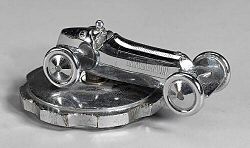
A Maserati Monoposto radiator mascot |
|
|
Text and photos published with the kind permission of Bonhams
Copyright © 2002-2007 Bonhams 1793 Ltd.,
Images and Text All Rights Reserved |
|
|
|


